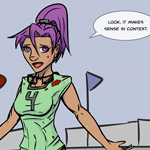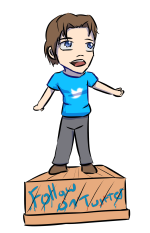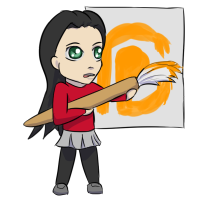It’s not a great secret that I run advertisements for The Far Side of Utopia – in fact, chances are, if you’re reading this you probably found it through one.
Advertising is an interesting game in this business – my money comes from ad revenue, of which I than spend a portion of to advertise; basically ads are feeding ads. This discussion never comes to pass without me linking to already established thoughts on this. But moving on!
I’ve endeavored to use and/or research most of the venues that you can advertise a webcomic, and have returned to share some of that meager knowledge with you. While I won’t be posting exact numbers, I will be giving a general sentiment of what venues to consider, and what to consider them for. For a summary, you can skip to the TL;DR at the bottom.
Project Wonderful:
Project Wonderful is probably the first thing that comes to mind when someone talks about advertising a webcomic. While it may have a wonderful model, unfortunately it’s got some severe limitations as well.
Let me start by saying that if you’ve never advertised anyway, it’s a really good place to start. More important than it’s list of pros is that its very transparent and noob friendly – you can poke around, place a few cautious ads here and there, and even start advertising for free to get a sense of the game, what ads are getting high click through rates, and generally get comfortable the idea. And it has some decent pros:
- If you’re willing to manage your ad campaign by hand, you can get a superior cost per click out of Project Wonderful to anything else.
- You can support other creators you like by directly placing your ad on their site.
- You are pretty much hitting core webcomic audience – not only do few non-webcomic sites use Project Wonderful, you can use the search functions to narrow it down to webcomic sites only.
- You can place free ads.
Between those pros, I’d say it places not only as my suggested starting point for advertising your comic, but retains a spot for consideration even down the road. But, while not necessarily a dying service, it is a severely limited service.
Few major webcomics run it anymore, and since it doesn’t have any concept of partial purchase of ad space (you have to be the winning bidder for all traffic in a region) any major website that DOES run it will be prohibitively expensive.
While you can automate your bidding on small sites into a campaign, it’s less effective than bidding by hand – many of the ad slots you’ll pick up will be less than ideally located. With other service this matters little (as you only pay if its clicked, you don’t care if your ad is at the bottom of page since you won’t have to pay), with Project Wonderful and the fact that you can’t really sort ad spaces by how many clicks they get, just how many ad loads they get, this is a fairly significant problem. Ultimately a decent campaigns CPC (cost per click) will be fairly comparable to other options.
Google Adwords:
Google adwords is a pain-in-the-ass for webcomics. They have an easy mode, but unfortunately the easy mode does not understand what a webcomic is, and I cannot recommend using it.
Ultimately you’ll want to set it up manually, and focus your ads into the Display Network, and than curate out the sites that are off market. This isn’t particularly hard, and can be done without a tutorial or prior training, but will require some poking and effort, and I cannot recommend it as your first foray into ads.
Obviously the nice part of this is that you only pay when your ad is clicked on – but its not quite that simply. Many people will click a shiny image ad without really intending to read a webcomic.
Some tips:
- Put a little more info on your ad – webcomic, genre, maybe a little blurb. Only want people that might be interested to click on it. While in Project Wonderful high click-through ads are great since you want to catch as many clicks as possible, here you want the best clicks possible – click bait (joke, fanservice, etc) is usually a bad idea unless it represents your comic well.
- Curate by cost. You don’t have to go through all the placements; just take a gander at what is racking up a tab and see if its on target audience.
Ultimately the best part of Google Adwords is that it is infinitely scale-able. You can spend a couple bucks a day or drop hundreds without seeing a plunge in effectiveness or hit an upper limit of cost-effectiveness that Project Wonderful has.
It’s good for large and small campaigns alike, but is definitely complicated.
Comic Rocket:
You can advertise on Comic Rocket – while I’ve questioned their service reliability in the past it seems that they’ve moved beyond their hiccups and are now kicking along. I wouldn’t necessarily call the reach of their network vast – they seem to not have that many publishers for their ads. That said, it’s not a bad option.
Comic Rocket you pay per impression, not clicks. This means you are back to looking for a high-click ad; something that will grab the attention of anyone that might be a possible reader of your comic. On the bright side their publisher agreement stipulates running the ad next to the comic, so you have to worry about picking up bad ad space a lot less than Project Wonderful campaigns. That said, the ad will link to your comic framed by Comic Rocket (that’s why it’s discounted for webcomics, it’s doubling as a Comic Rocket ad).
Ultimately if you have some money left over in your ad budget, give it a shot. Not only will it bring in readers it’ll put ’em in an interface where it’s easy for them to subscribe to your comic. Personally I don’t find the advertising by genre (which inexplicable DOUBLES THE PRICE) to be anywhere near worth the difference in price. Having run both I’m fairly confident in recommending you stay clear of the extra cost there.
That said, with its limited reach (purely appearing on mostly small webcomics) it’s not going to be a major traffic driver no matter how much money you through at it, and its cost-per-click tends to average out fairly high compared to the other options.
Hiveworks:
So let me put on the table from the start that as their site clearly states their monthly minimum is $250 dollars. That’s a pretty big barrier to entry. That said, it means that your ad is being placed on some of the biggest highest traffic webcomics in the business.
There are a few problems with this route – while they are friendly and helpful, there is ultimately fairly little transparency – you put in money and see what happens. While you can give some input on where and when it’ll run, the levers are obviously going to be less exhaustive than something like Adwords or Project Wonderful where you have very high granularity on your campaign.
On the flipside though, this was a true torrent of traffic. If you want to throw money into the hopper, you will get a lot of hits. This network dwarfs the traffic of Project Wonderful at this point, and far far more importantly you can do a partial buy. To get onto a major webcomic in Project Wonderful you need to buy all the traffic – this can set you back more than a hundred dollars A DAY. With Hiveworks, your ad will just be mixed into the ad soup; this allows it to appear on sites that you would otherwise not be able to afford.
It’s great for a burst of traffic, and it’s great to get your ad in front webcomic fans you couldn’t reach otherwise, but you have to pay for CPM (Cost-Per-1000 impression) meaning you’re not guaranteed clicks or even that your money will get you a predictable amount of clicks.
That said, if you are a big enough comic to have that budget, you’re probably already part of Hiveworks. It’s a great traffic hose for a promotion – running a kickstarter? Starting a shiny new webcomic? Maybe a good idea to kick up a lot of interest fast. As a long term game plan I can’t imagine most people could afford it out of their budget.
Top Web Comics:
You can buy both ad space or a sponsorship box with them. There isn’t much to say about this beyond that both are among the best ad space you can buy per dollar. Frankly I’m going to be a little surprised if the price doesn’t go up soon. The banner ads along the site are frequently sold out.
Not only do you get pure, juicy, undiluted webcomic reader traffic, you get people that are inclined to vote on TWC. It’s not quite the same level of traffic as Hiveworks, but you have a good bit more control and the buy in is much cheaper (since you can buy as little as a single day) and the sponsorship is cheap.
Let’s be clear – if your ad budget covers $15 a month or more, I cannot see any reason to not buy a sponsorship square. It’s just better than per dollar than any other option in my experience.
The banners are a lot more expensive cost-per-click, but are some of the cheaper levers you can pull for the level of traffic they bring in; that said, their reach is mostly repeat TWC readers – they have high diminishing returns. This makes me give them (the banner ads) the same recommendation as Hiveworks; great for a campaign, in the long run, probably not worth the expense.
The Webcomic List:
An honorable mention to this list. It’s got only one buy in (a tiny sponsorship square) and drives a pretty small amount of traffic, but is pretty cheap. If you have extra change in the bottom of your ad revenue bucket, it’s a decent place to throw it. If you have a huge budget and want full coverage, it’s cost to traffic is solid.
I hope this provided some insight. I could provide more hard numbers, but frankly a general comparison is both easier to chew and probably more useful. My numbers won’t match your numbers, but my general experience will probably match your general experience.
Allow me to summarize with a TL;DR…
Project Wonderful: Yes. Start here, phase into a modest campaign eventually.
Google Adwords: Conditional. When you’ve mined out Project Wonderful and phased over to a campaign, you can go here. Very flexible. Don’t use the quick setup – it doesn’t understand webcomics and will throw in a lot of things you don’t want to bid on.
Comic Rocket: Optional. Not really going to change your traffic profile much, but not a bad investment.
Hiveworks: Conditional. Sort of like an expensive firehose of traffic. Good for campaigns, but costly.
Top Web Comics: Yes. The banners are probably overkill unless you want a lot of traffic coming through for a campaign.
The Webcomic List: Optional. Minimal traffic will trickle through it, but its not a bad return on investment.
Got a specific question? Ask! Either comment here or shoot me an email through the address on my contact page.
Hope this helped.
EDITING TO AN A LITTLE MORE INFO:
I got asked a few times for a bit more info on the traffic numbers, I shared this info over on a post on the Underdog forums, so I’ll share it over here.
As far volume of traffic, I can provide the data here, but want to qualify why I didn’t this originally.
These numbers are still being crunched on my side; I’m still working on understanding them, and most importantly I don’t have good user retention data on them yet!
Giant qualifiers to this data (there is a reason I’m not publishing raw info!):
- Timeframes are not lined up; Hiveworks was a little over a week of ads, TWC and PW are ~2.5 months of ad data, TWL is little over a month.
- User retention rates I’m still digging into.
- I’m only counting new users. There is a lot of value in dangling your comic in front of someone that isn’t a new user and reminding them you exist, but this is a lot harder to pull meaningful data on.
Hiveworks: ~1500 new users / ~ .16 per user
TWC: ~665 new users / ~.04 per user
PW: ~1500 new users / ~.12 per user
TWL: ~110 new users / ~.13 per user
AdWords: ~265 / ~.06 per user.*
Comic Rocket: Cannot be calculated.**
* It’s worth noting that this is only as good as it appears if you place the value of your time to zero. It’s good – obviously, Google is the best in the business as far as ad services go, but your numbers will be a lot worse if you plunge into this carelessly.
** Comic Rocket cannot be easily calculated because it frames your site and doesn’t play nice with google analytic or other referral tracking. At worst you don’t see them at all, and at best it treats every time the user flips the page as a new referral generated ludicrous numbers.
If I ever think I’ve got a meaningful read of the numbers with a nuanced picture, I’ll put up a blog post on that as well, for now I’m just giving you some raw data as you mentioned a curiosity.
And yes, Top Webcomic Banner ads are often good to plan in advance, but keep in mind they are only quite so ridiculous as they are right now because Hiveworks just straight up bought them all. Normally you can usually get a few days here and there within a week or so of wanting it. That said, the price is probably too cheap right now and they tend to sell out a lot – also the big kids like Hiveworks may continue to just buy them out due to the low price point per effectiveness.
There is something else I’d like to touch on that I will also address in a future blog post. When you talk about ad-traffic people turn up their noses and point to social media as giving out superior numbers for free. This isn’t untrue, but there are three points: Social Media traffic engagement is often very low, social media traffic is valued very little by Google Adsense (as they know that), and Social Media (Reddit in particular) has a very high percentage of ad-block traffic; Social Media is a very good source of traffic, but unless you are donation/patreon supported rather than ad supported, social media traffic is worth a let less revenue per head. This doesn’t discredit as a source of traffic, but something worth noting when looking at numbers.
As with everything I do and give advice on, let me end with the giant disclaimer. I have some knowledge that I’m happy to share, but I’m just a dude that’s learning and passing along what he learns. I’m learning to write, I’m learning to draw, I’m learning to market, and I’m learning how to run a webcomic – I have a pretty broad background of experience, but never take my opinion as an expert opinion.




Discussion (6) ¬
What are the best free advertising alternative project wonderful? Because project wonderful is shut down.
Saw your forum thread on Underdogs and wanted to take a look. I’m trying to strategically plan an Ad campaign to boost my readers, and this has helped immensely! I definitely think I’m going to try TWC.
Saw your post on Underdogs. Thanks for taking the time to put all this together. I’ve tried PW, and because of your findings I may test out TWC next. Cheers!
Thanks for this review, it was very helpful!